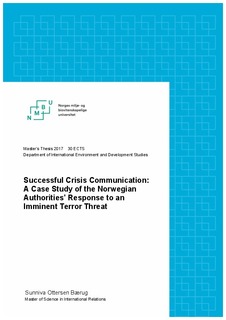| dc.description.abstract | When societies are faced with a crisis, the reputation, or even the fate, of the authorities hangs in the balance. If the authorities manage to communicate their handling of the crisis successfully, the crisis can strengthen credibility and trust between the public and its authorities. But if they don’t succeed, the crisis can discredit the authorities. This study explores how the Norwegian Government and the Norwegian Police Security Service (PST) successfully managed to communicate an imminent terror threat to the general public during the summer of 2014. This is examined in a qualitative study that applies theory within crisis communication and framing. Based on the theories, this study understands successful crisis communication as the authorities’ ability to show their side of the story and get their frames accepted by the media, and hereby win the dominant narrative of the crisis. This study proves the “evade responsibility frame”, the “reducing the offensiveness frame”, the “cultural congruence frame” and the “united management frame” to be central in the crisis communication by PST and the Government. The study further concludes that the media accepted these frames and that these frames were successfully disseminated in the media coverage, which contributed to shape the authorities’ handling of the crisis as successful. The only critical frame detected in the media coverage was the “exploitation of the crisis frame”. Within the “exploitation of the crisis frame” the media commentators warned about possible exploitation of the event and unfortunates consequences, for example that this event could be used to implement new policies that could be deemed detrimental to an open democracy. However, based on the media’s overall acceptance of the authorities’ frames, it is safe to conclude that PST and the Government successfully managed to communicate the terrorism threat. The authorities managed to win the dominant narrative of the crisis, which contributed to define the authorities’ handling of the crisis as successful and must likely shape public opinion in their favour. In this study, I have thus demonstrated how a crisis does not only pose a threat towards the authorities, but also an opportunity if the crisis is communicated successfully. | nb_NO |

